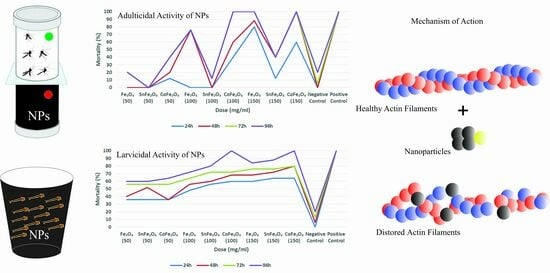Pesticide Efficiency of Environment-Friendly Transition Metal-Doped Magnetite Nanoparticles
Abstract
1. Introduction
2. Materials and Methods
2.1. Synthesis of Nanoparticles
2.2. Characterization Techniques
2.3. Larvicidal Assay of Nanoparticles
2.4. Adulticidal Behavior of Nanoparticles
3. Results and Discussion
3.1. Surface Morphology and Elemental Analysis of Nanoparticles
3.2. Vibrating Sample Magnetometry of Nanoparticles
3.3. X-ray Diffraction Analysis of Nanoparticles
3.4. Fourier Transform Infrared Spectroscopy of Nanoparticles
3.5. Larvicidal Efficiency of Nanoparticles
3.6. Adulticidal Efficacy of Nanoparticles
3.7. Damages to the Gut Induced by Nanoparticles
3.8. Comparative Study
4. Conclusions
Author Contributions
Funding
Data Availability Statement
Acknowledgments
Conflicts of Interest
References
- Benelli, G.; Maggi, F.; Pavela, R.; Murugan, K.; Govindarajan, M.; Vaseeharan, B.; Petrelli, R.; Cappellacci, L.; Kumar, S.; Hofer, A.; et al. Mosquito Control with Green Nanopesticides: Towards the One Health Approach? A Review of Non-Target Effects. Environ. Sci. Pollut. Res. 2018, 25, 10184–10206. [Google Scholar] [CrossRef]
- Bhatt, S.; Gething, P.W.; Brady, O.J.; Messina, J.P.; Farlow, A.W.; Moyes, C.L.; Drake, J.M.; Brownstein, J.S.; Hoen, A.G.; Sankoh, O.; et al. The Global Distribution and Burden of Dengue. Nature 2013, 496, 504–507. [Google Scholar] [CrossRef]
- Benelli, G.; Caselli, A.; Canale, A. Nanoparticles for Mosquito Control: Challenges and Constraints. J. King Saud Univ.-Sci. 2017, 29, 424–435. [Google Scholar] [CrossRef]
- Clemons, A.; Haugen, M.; Flannery, E.; Tomchaney, M.; Kast, K.; Jacowski, C.; Le, C.; Mori, A.; Holland, W.S.; Sarro, J.; et al. Aedes aegypti: An Emerging Model for Vector Mosquito Development. Cold Spring Harb. Protoc. 2010, 2010, pdb.emo141. [Google Scholar] [CrossRef]
- Lamy, K.; Tran, A.; Portafaix, T.; Leroux, M.D.; Baldet, T. Impact of Regional Climate Change on the Mosquito Vector Aedes albopictus in a Tropical Island Environment: La Réunion. Sci. Total Environ. 2023, 875, 162484. [Google Scholar] [CrossRef]
- Brühl, C.A.; Després, L.; Frör, O.; Patil, C.D.; Poulin, B.; Tetreau, G.; Allgeier, S. Environmental and Socioeconomic Effects of Mosquito Control in Europe Using the Biocide Bacillus thuringiensis Subsp. israelensis (Bti). Sci. Total Environ. 2020, 724, 137800. [Google Scholar] [CrossRef]
- Naqqash, M.N.; Gökçe, A.; Bakhsh, A.; Salim, M. Insecticide Resistance and Its Molecular Basis in Urban Insect Pests. Parasitol. Res. 2016, 115, 1363–1373. [Google Scholar] [CrossRef]
- Ghramh, H.A.; Al-Ghamdi, K.M.; Mahyoub, J.A.; Ibrahim, E.H. Chrysanthemum Extract and Extract Prepared Silver Nanoparticles as Biocides to Control Aedes aegypti (L.), the Vector of Dengue Fever. J. Asia Pac. Entomol. 2018, 21, 205–210. [Google Scholar] [CrossRef]
- Parthiban, E.; Manivannan, N.; Ramanibai, R.; Mathivanan, N. Green Synthesis of Silver-Nanoparticles from Annona reticulata Leaves Aqueous Extract and Its Mosquito Larvicidal and Anti-Microbial Activity on Human Pathogens. Biotechnol. Rep. 2019, 21, e00297. [Google Scholar] [CrossRef] [PubMed]
- Sundararajan, B.; Kumari, B.D.R. Novel Synthesis of Gold Nanoparticles Using Artemisia vulgaris L. Leaf Extract and Their Efficacy of Larvicidal Activity against Dengue Fever Vector Aedes aegypti L. J. Trace Elem. Med. Biol. 2017, 43, 187–196. [Google Scholar] [CrossRef] [PubMed]
- Narayanan, M.; Devi, P.G.; Natarajan, D.; Kandasamy, S.; Devarayan, K.; Alsehli, M.; Elfasakhany, A.; Pugazhendhi, A. Green Synthesis and Characterization of Titanium Dioxide Nanoparticles Using Leaf Extract of Pouteria campechiana and Larvicidal and Pupicidal Activity on Aedes aegypti. Environ. Res. 2021, 200, 111333. [Google Scholar] [CrossRef] [PubMed]
- Rajagopal, G.; Nivetha, A.; Sundar, M.; Panneerselvam, T.; Murugesan, S.; Parasuraman, P.; Kumar, S.; Ilango, S.; Kunjiappan, S. Mixed Phytochemicals Mediated Synthesis of Copper Nanoparticles for Anticancer and Larvicidal Applications. Heliyon 2021, 7, e07360. [Google Scholar] [CrossRef] [PubMed]
- Selvan, S.M.; Anand, K.V.; Govindaraju, K.; Tamilselvan, S.; Kumar, V.G.; Subramanian, K.S.; Kannan, M.; Raja, K. Green Synthesis of Copper Oxide Nanoparticles and Mosquito Larvicidal Activity against Dengue, Zika and Chikungunya Causing Vector Aedes aegypti. IET Nanobiotechnol. 2018, 12, 1042–1046. [Google Scholar] [CrossRef] [PubMed]
- Chithiga, A.; Manimegalai, K. Biosynthesis of Zinc Oxide Nanoparticles Using Indigofera tinctoria and Their Efficacy against Dengue Vector, Aedes aegypti (Diptera: Culicidae). Exp. Parasitol. 2023, 249, 108513. [Google Scholar] [CrossRef] [PubMed]
- Su, C. Environmental Implications and Applications of Engineered Nanoscale Magnetite and Its Hybrid Nanocomposites: A Review of Recent Literature. J. Hazard. Mater. 2017, 322, 48–84. [Google Scholar] [CrossRef]
- Iannone, M.F.; Groppa, M.D.; de Sousa, M.E.; van Raap, M.B.F.; Benavides, M.P. Impact of Magnetite Iron Oxide Nanoparticles on Wheat (Triticum aestivum L.) Development: Evaluation of Oxidative Damage. Environ. Exp. Bot. 2016, 131, 77–88. [Google Scholar] [CrossRef]
- Nkurikiyimfura, I.; Wang, Y.; Safari, B.; Nshingabigwi, E. Temperature-Dependent Magnetic Properties of Magnetite Nanoparticles Synthesized via Coprecipitation Method. J. Alloys Compd. 2020, 846, 156344. [Google Scholar] [CrossRef]
- Martianasari, R.; Hamid, P.H. Larvicidal, Adulticidal, and Oviposition-Deterrent Activity of Piper betle L. Essential Oil to Aedes aegypti. Vet. World 2019, 12, 367–371. [Google Scholar] [CrossRef]
- Mattingly, P.F. A Technique for Feeding Adult Mosquitoes. Nature 1946, 158, 751. [Google Scholar] [CrossRef]
- Rajendar, B.; Mulagalapati, R.; Reddy, M.V.N.J.; Patri, S.; Karthik, Y.K.; Matur, R.V. 2-Phenoxyethanol: A Novel Reagent for Improved Sensitivity of Carbohydrate Quantification. Anal. Biochem. 2020, 595, 113624. [Google Scholar] [CrossRef]
- Bhattacharya, P.; Neogi, S. Gentamicin Coated Iron Oxide Nanoparticles as Novel Antibacterial Agents. Mater. Res. Express 2017, 4, 95005. [Google Scholar] [CrossRef]
- Prilepskii, A.Y.; Fakhardo, A.F.; Drozdov, A.S.; Vinogradov, V.V.; Dudanov, I.P.; Shtil, A.A.; Bel’tyukov, P.P.; Shibeko, A.M.; Koltsova, E.M.; Nechipurenko, D.Y.; et al. Urokinase-Conjugated Magnetite Nanoparticles as a Promising Drug Delivery System for Targeted Thrombolysis: Synthesis and Preclinical Evaluation. ACS Appl. Mater. Interfaces 2018, 10, 36764–36775. [Google Scholar] [CrossRef]
- Rathi, P.L.; Deepa, S. Structural, Magnetic, Thermal and Optical Properties of Sn2+ Cation Doped Magnetite Nanoparticles. Ceram. Int. 2020, 46, 2969–2978. [Google Scholar] [CrossRef]
- Soonwera, M.; Phasomkusolsil, S. Adulticidal, Larvicidal, Pupicidal and Oviposition Deterrent Activities of Essential Oil from Zanthoxylum limonella Alston (Rutaceae) against Aedes aegypti (L.) and Culex quinquefasciatus (Say). Asian Pac. J. Trop. Biomed. 2017, 7, 967–978. [Google Scholar] [CrossRef]
- Janeh, M.; Osman, D.; Kambris, Z. Damage-Induced Cell Regeneration in the Midgut of Aedes albopictus Mosquitoes. Sci. Rep. 2017, 7, 44594. [Google Scholar] [CrossRef]
- Von Der Ecken, J.; Müller, M.; Lehman, W.; Manstein, D.J.; Penczek, P.A.; Raunser, S. Structure of the F-Actin–Tropomyosin Complex. Nature 2015, 519, 114–117. [Google Scholar] [CrossRef]
- Bernick, E.P.; Moffett, S.B.; Moffett, D.F. Organization, Ultrastructure, and Development of Midgut Visceral Muscle in Larval Aedes aegypti. Tissue Cell 2007, 39, 277–292. [Google Scholar] [CrossRef][Green Version]
- Korani, M.; Ghazizadeh, E.; Korani, S.; Hami, Z.; Mohammadi-Bardbori, A. Effects of Silver Nanoparticles on Human Health. Eur. J. Nanomed. 2015, 7, 51–62. [Google Scholar] [CrossRef]
- Araújo, P.S.; Caixeta, M.B.; Canedo, A.; da Silva Nunes, E.; Monteiro, C.; Rocha, T.L. Toxicity of Plant-Based Silver Nanoparticles to Vectors and Intermediate Hosts: Historical Review and Trends. Sci. Total Environ. 2022, 834, 155299. [Google Scholar] [CrossRef] [PubMed]
- Asma, U.; Morozova, K.; Ferrentino, G.; Scampicchio, M. Apples and Apple By-Products: Antioxidant Properties and Food Applications. Antioxidants 2023, 12, 1456. [Google Scholar] [CrossRef] [PubMed]
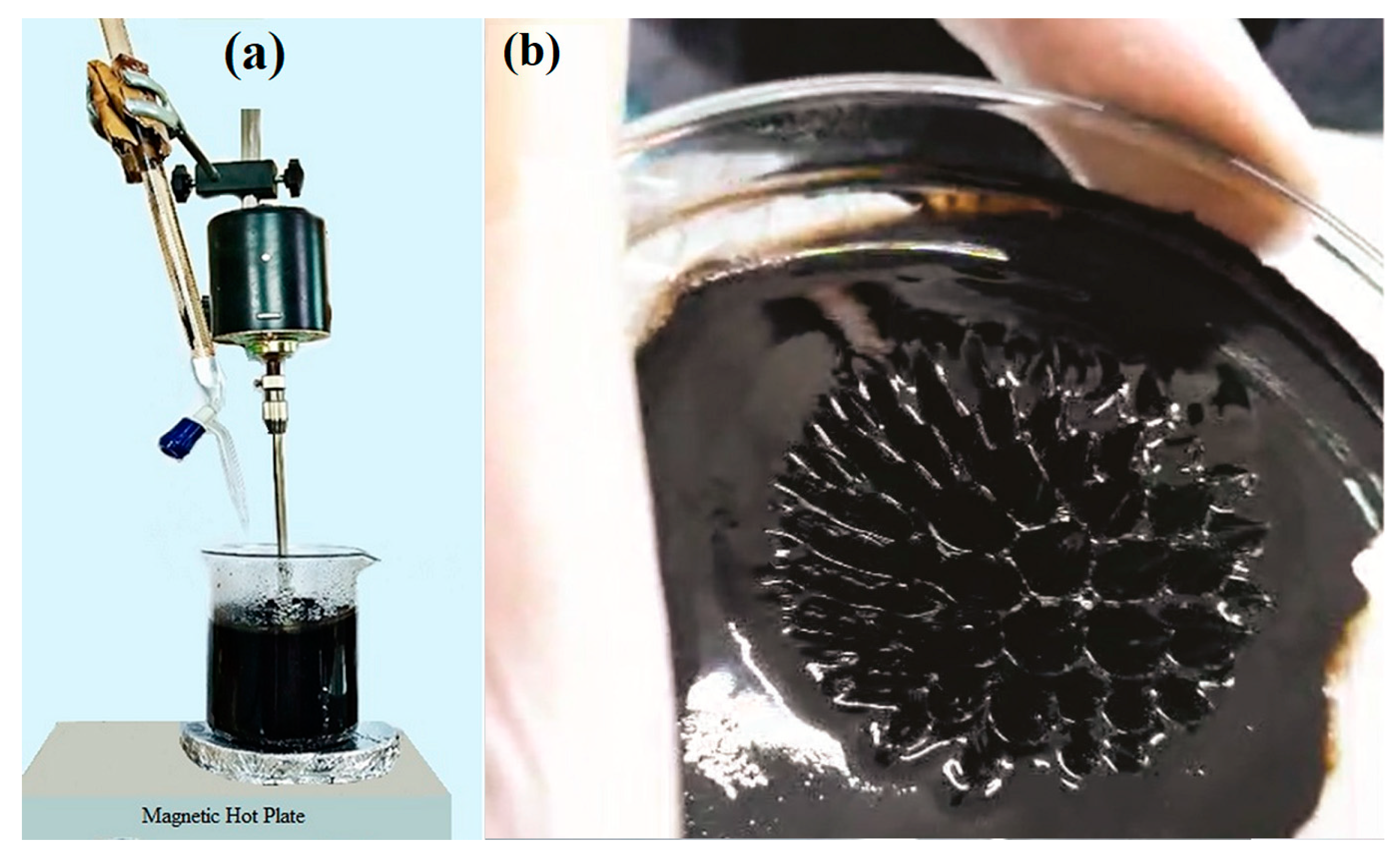
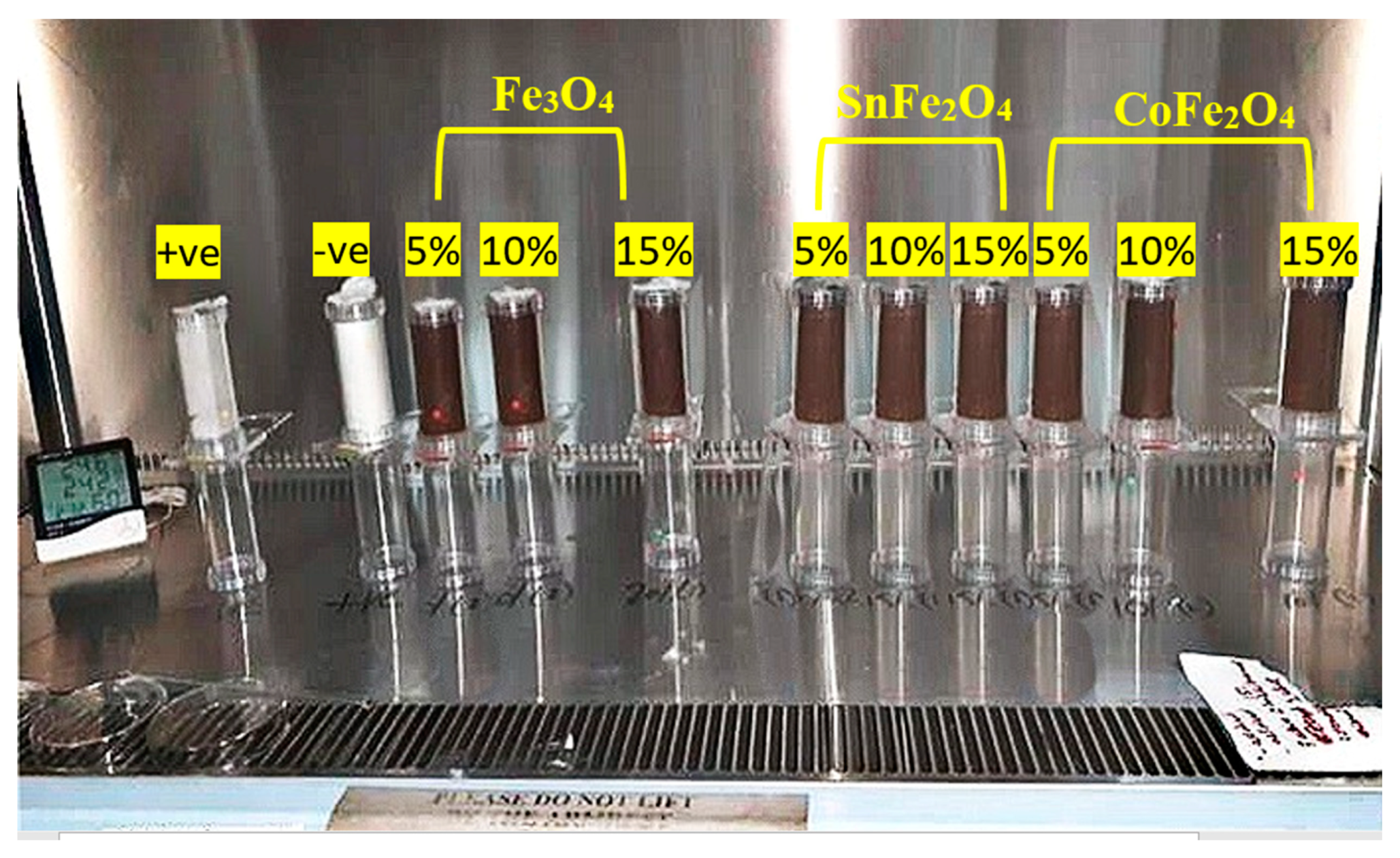

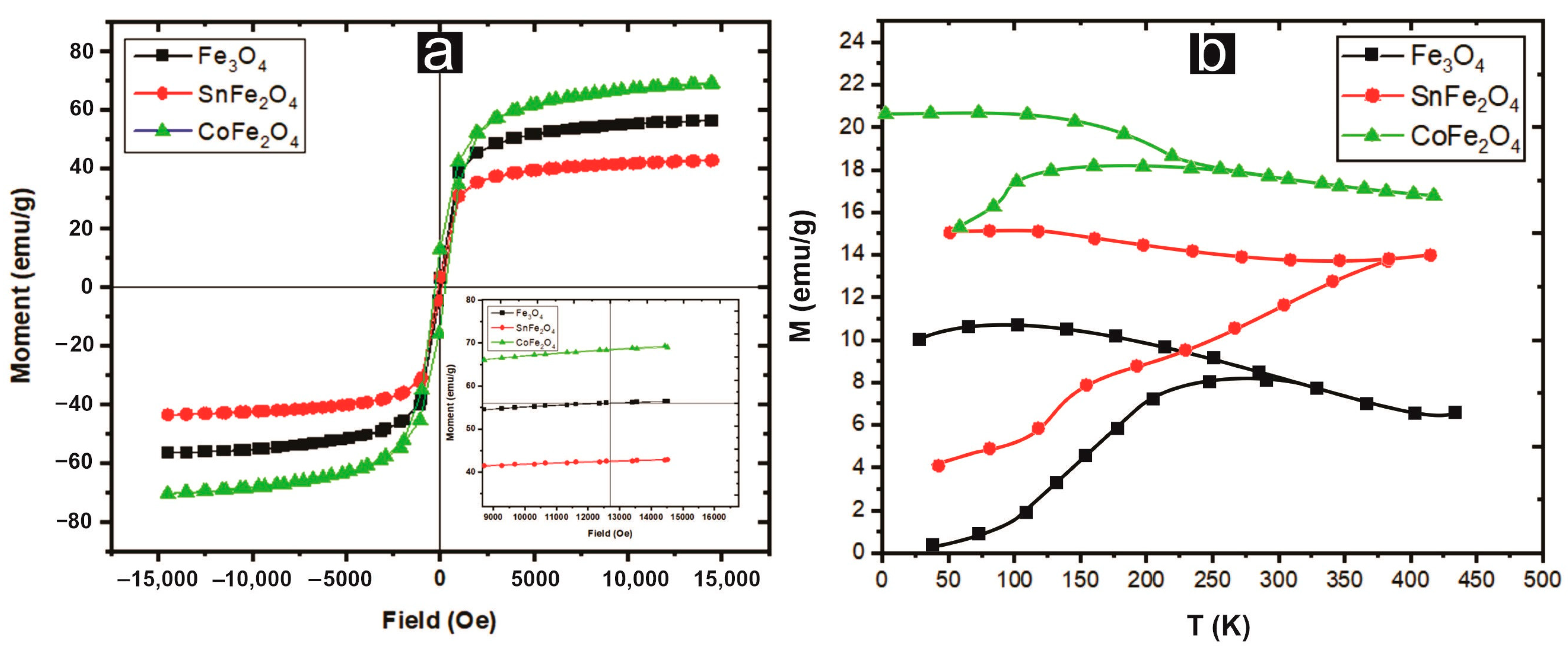

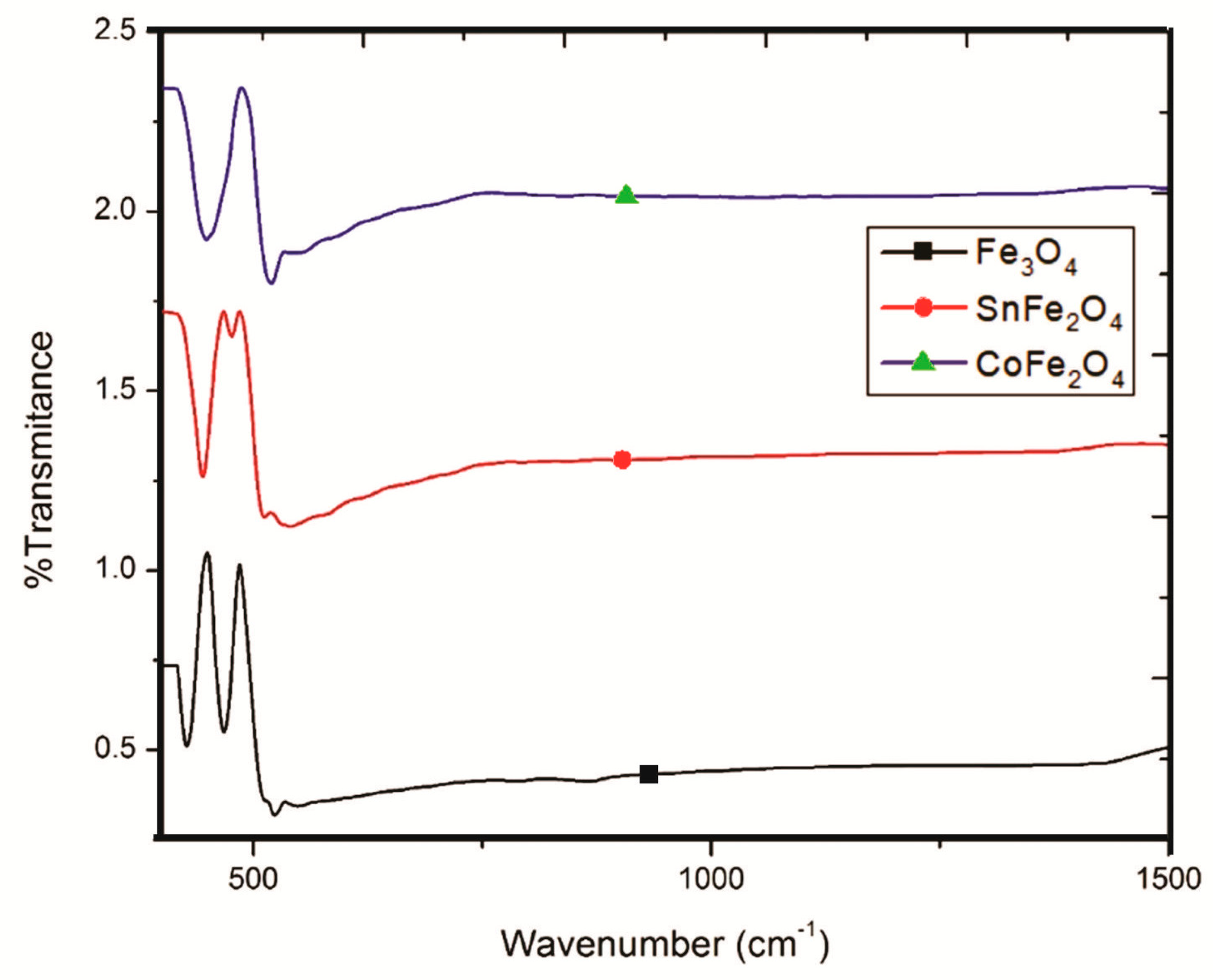
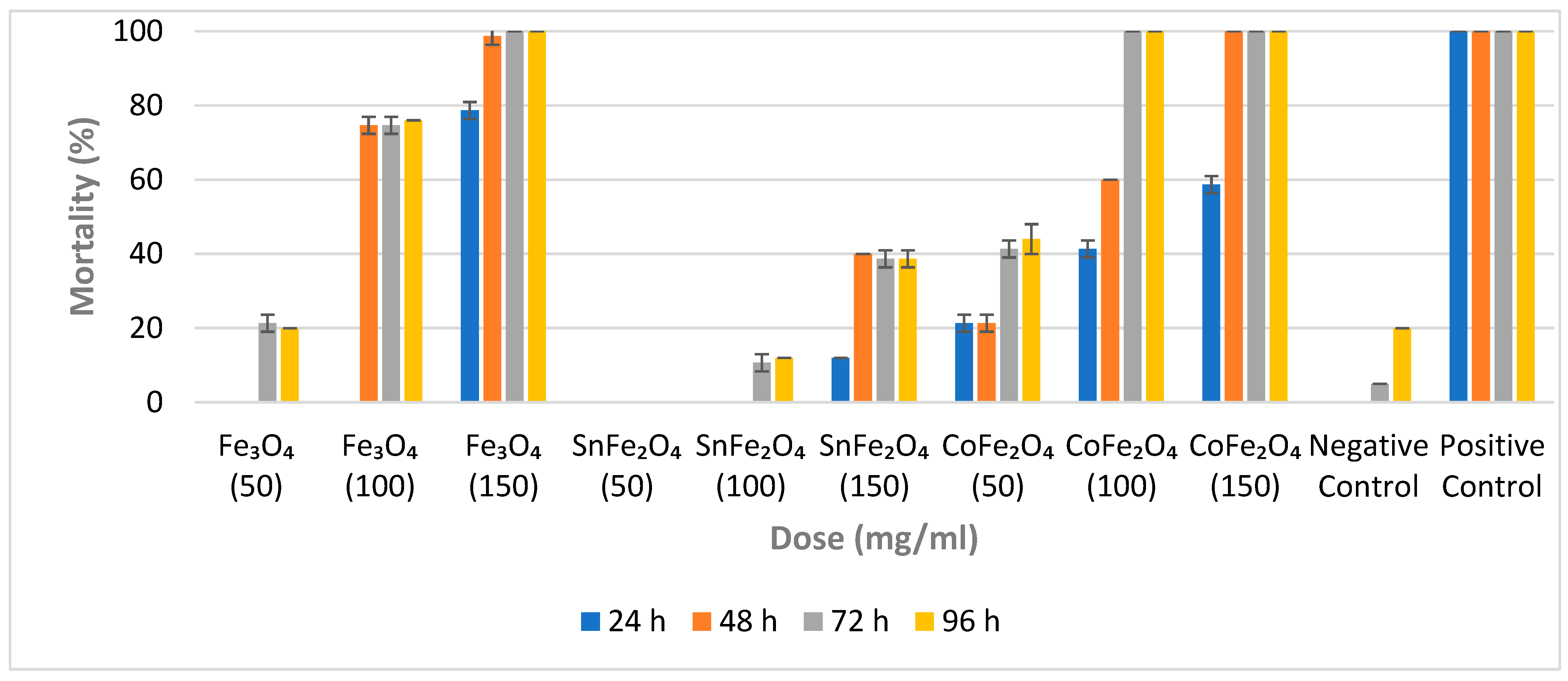
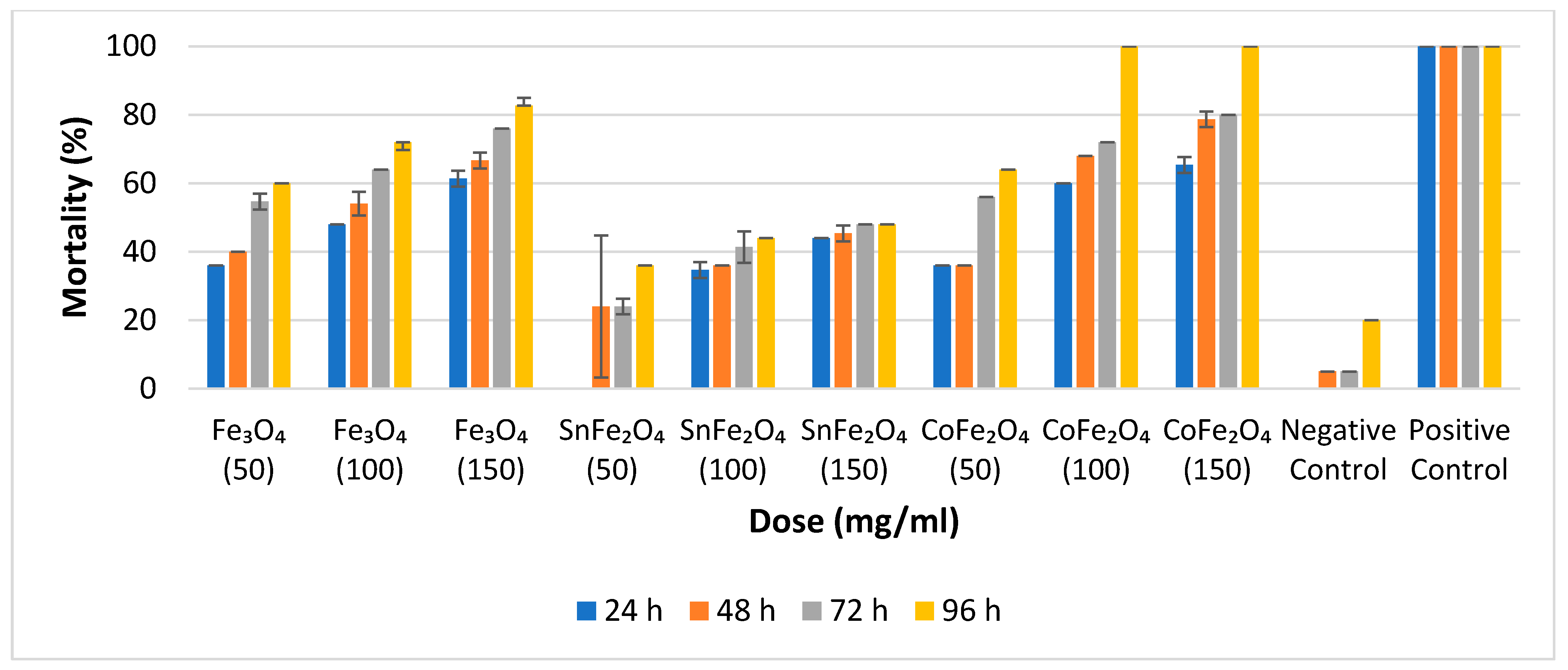
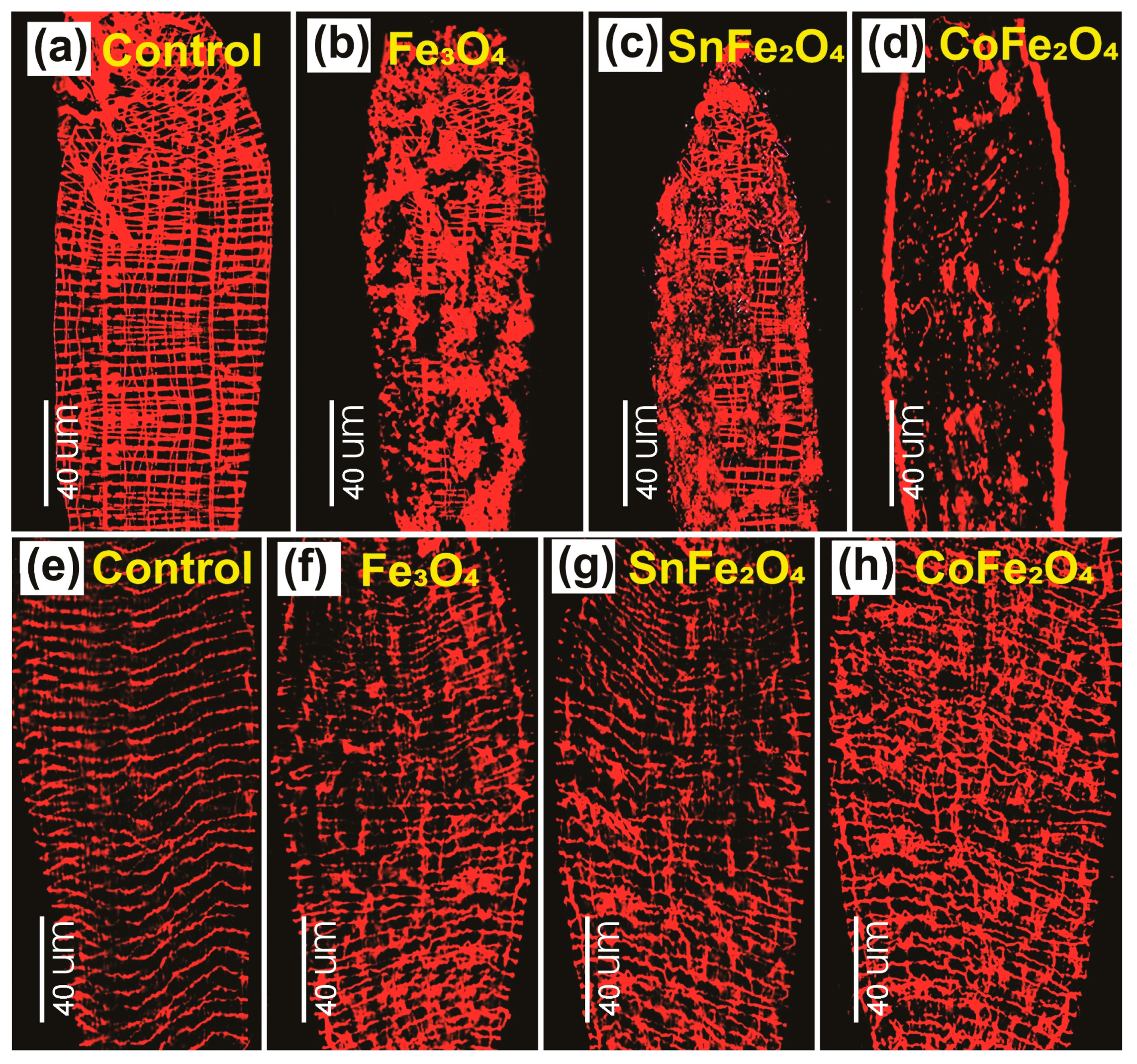
| Sample (NPs) | Ms (emu/g) | Mr (emu/g) | Mr/Ms | +Hc (Oe) | −Hc (Oe) | TB (K) | |
|---|---|---|---|---|---|---|---|
| Fe3O4 | 56.42 | 4.5 | 0.080 | 1.03 | 1.99 | 1.51 | 300 |
| SnFe2O4 | 42.00 | 1.7 | 0.040 | 71.85 | 118.44 | 105.145 | 387 |
| CoFe2O4 | 68.98 | 13.2 | 0.191 | 0.37 | 0.89 | 0.5375 | 262 |
Disclaimer/Publisher’s Note: The statements, opinions and data contained in all publications are solely those of the individual author(s) and contributor(s) and not of MDPI and/or the editor(s). MDPI and/or the editor(s) disclaim responsibility for any injury to people or property resulting from any ideas, methods, instructions or products referred to in the content. |
© 2024 by the authors. Licensee MDPI, Basel, Switzerland. This article is an open access article distributed under the terms and conditions of the Creative Commons Attribution (CC BY) license (https://creativecommons.org/licenses/by/4.0/).
Share and Cite
Shahzadi, S.; Hassan, J.U.; Oneeb, M.; Riaz, S.; Sharif, R.; Ban, D. Pesticide Efficiency of Environment-Friendly Transition Metal-Doped Magnetite Nanoparticles. Nanomaterials 2024, 14, 218. https://doi.org/10.3390/nano14020218
Shahzadi S, Hassan JU, Oneeb M, Riaz S, Sharif R, Ban D. Pesticide Efficiency of Environment-Friendly Transition Metal-Doped Magnetite Nanoparticles. Nanomaterials. 2024; 14(2):218. https://doi.org/10.3390/nano14020218
Chicago/Turabian StyleShahzadi, Shamaila, Jalees Ul Hassan, Muhammad Oneeb, Saira Riaz, Rehana Sharif, and Dayan Ban. 2024. "Pesticide Efficiency of Environment-Friendly Transition Metal-Doped Magnetite Nanoparticles" Nanomaterials 14, no. 2: 218. https://doi.org/10.3390/nano14020218
APA StyleShahzadi, S., Hassan, J. U., Oneeb, M., Riaz, S., Sharif, R., & Ban, D. (2024). Pesticide Efficiency of Environment-Friendly Transition Metal-Doped Magnetite Nanoparticles. Nanomaterials, 14(2), 218. https://doi.org/10.3390/nano14020218






